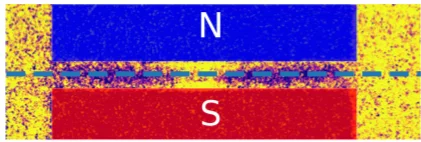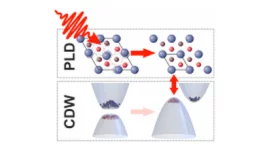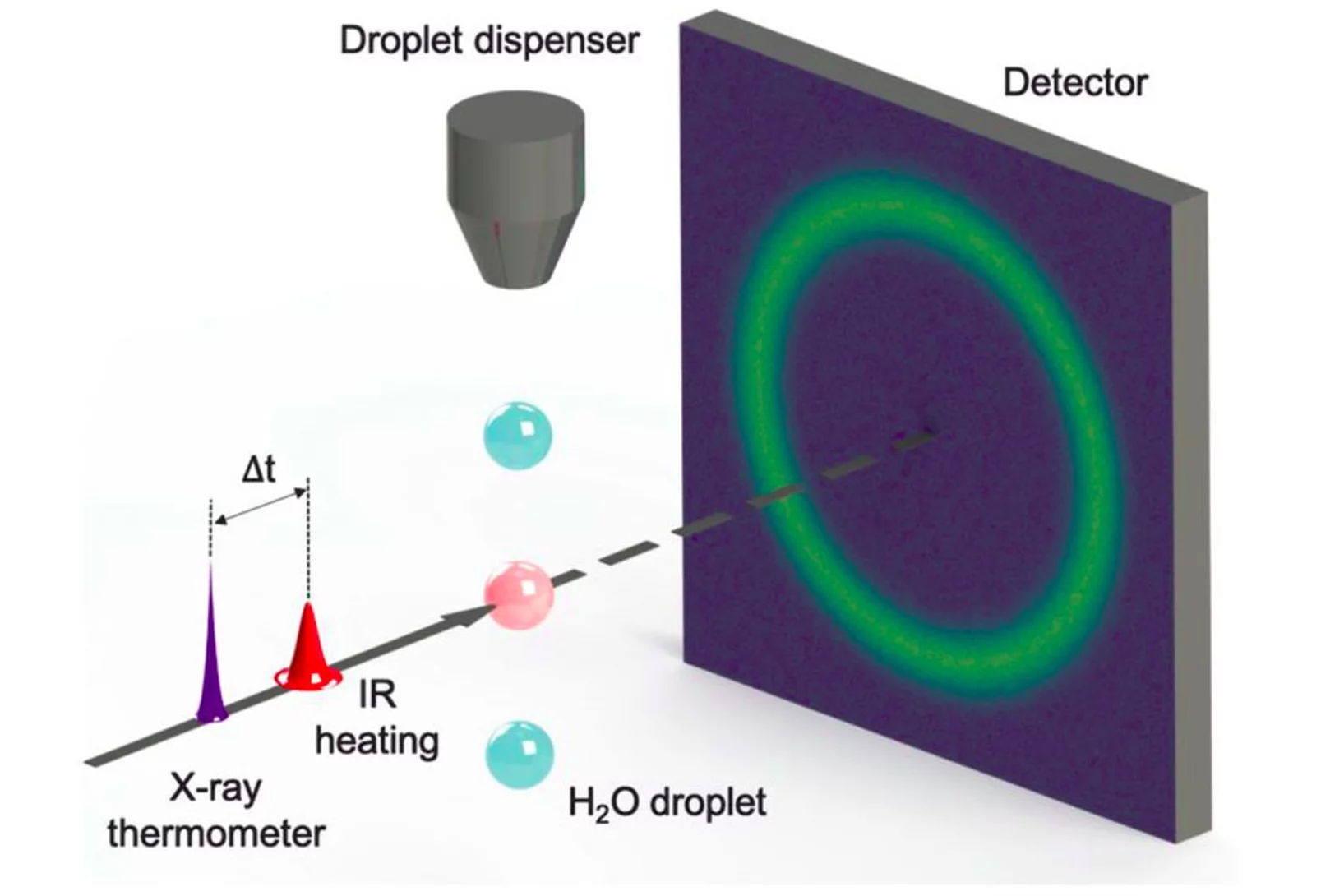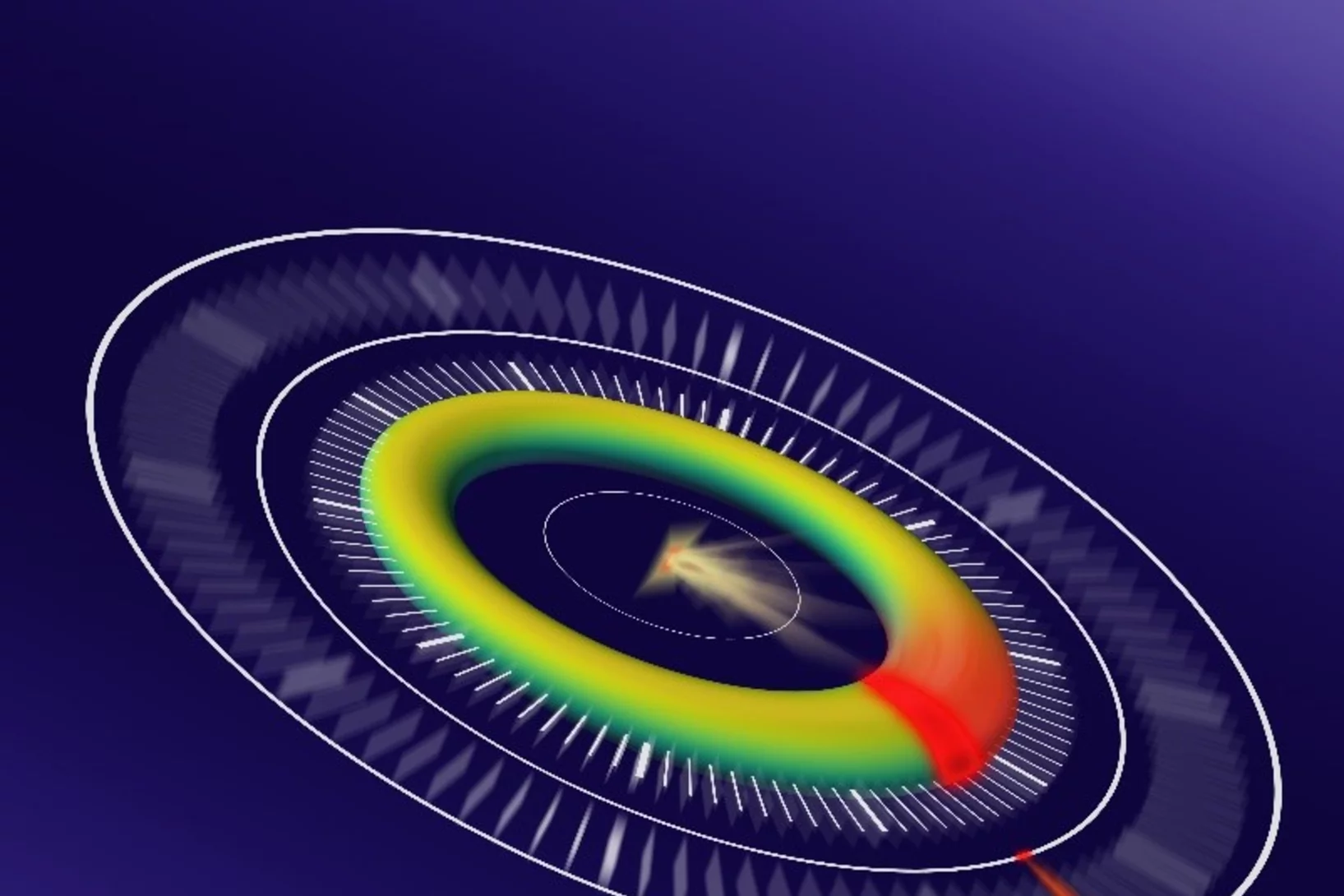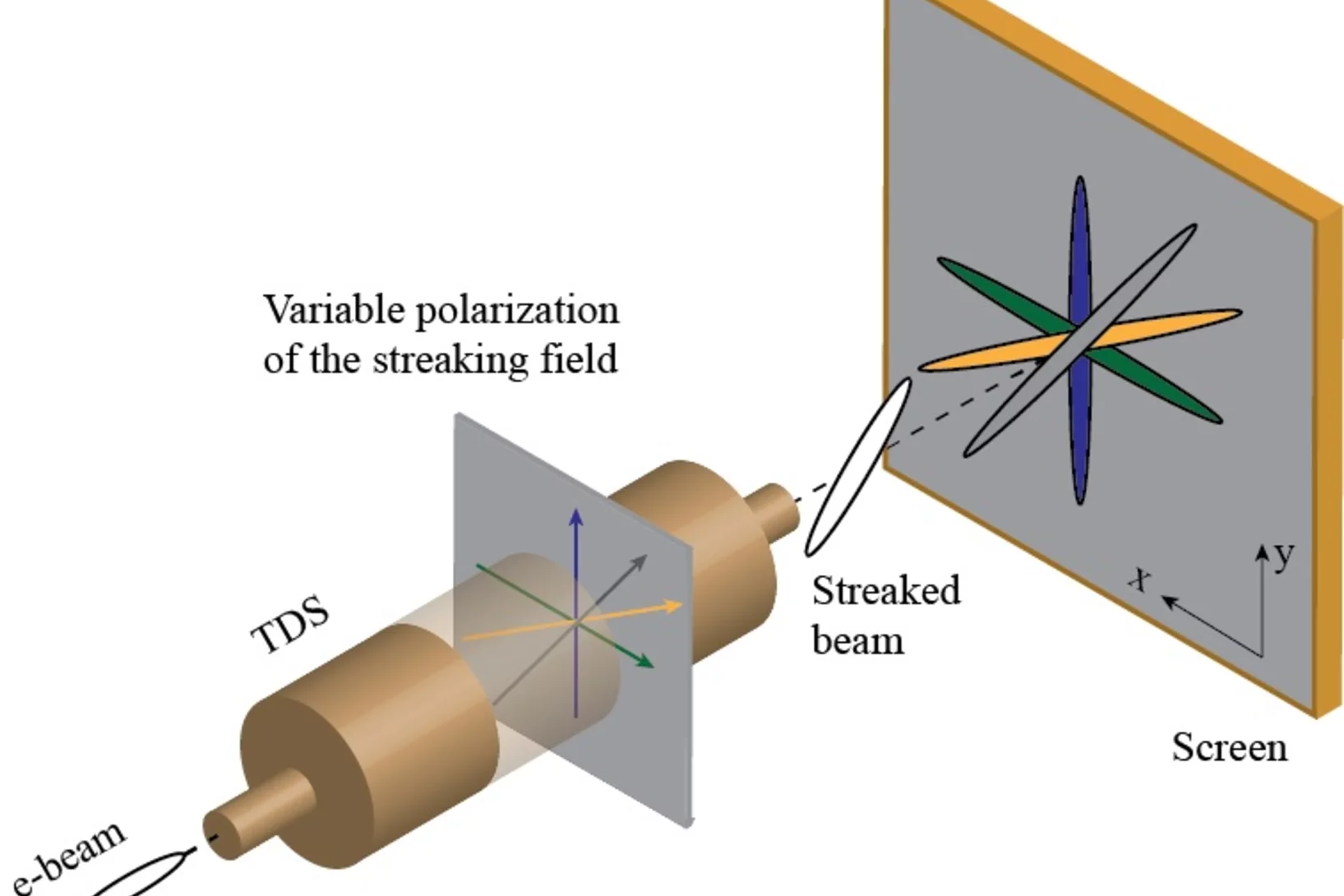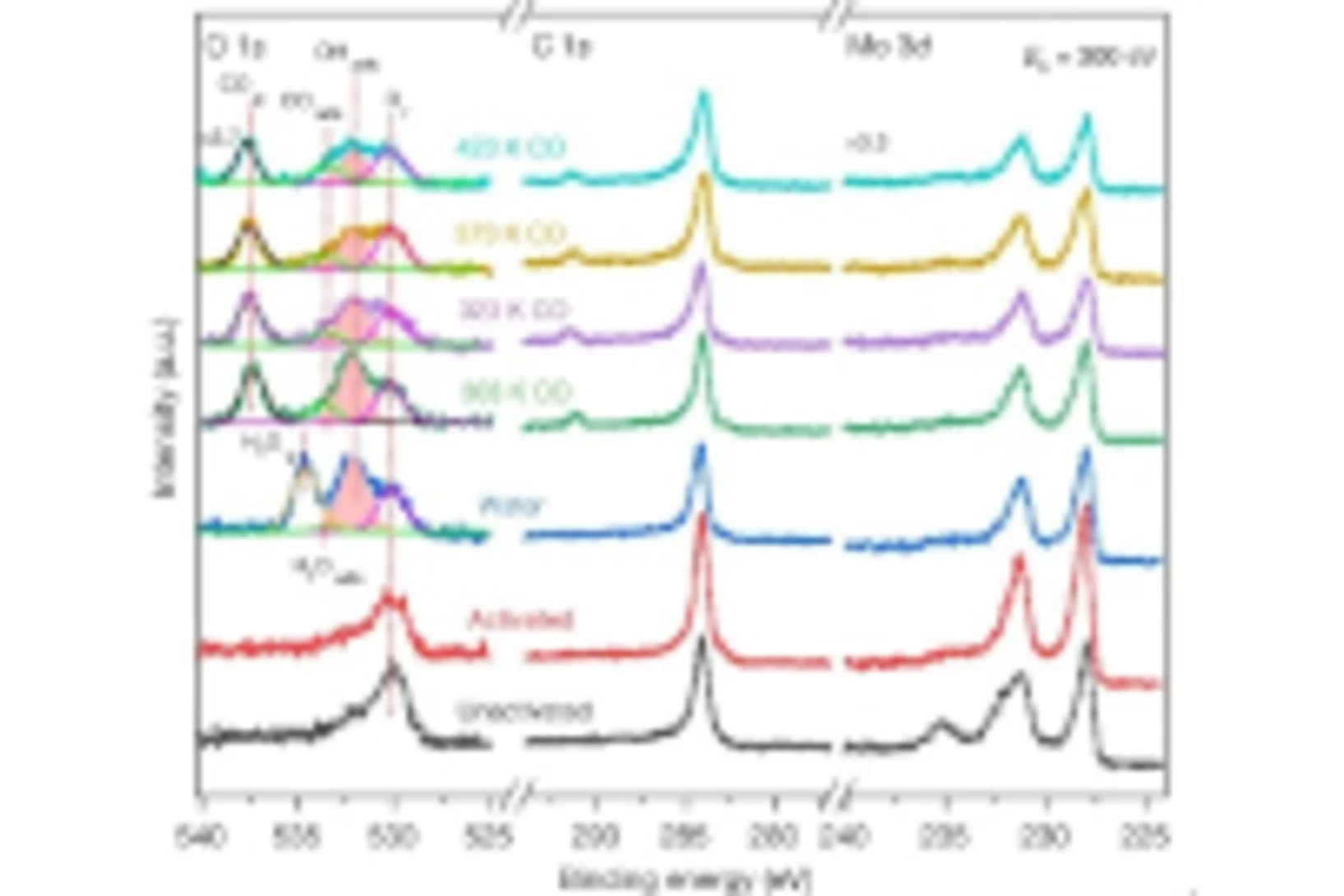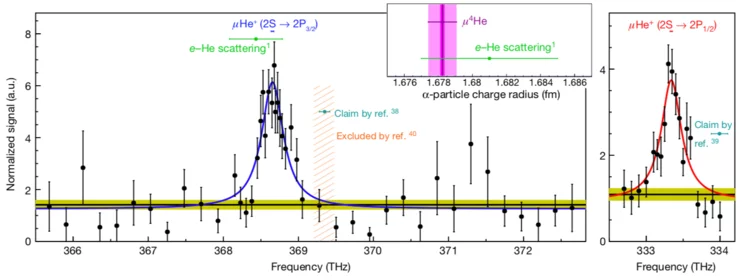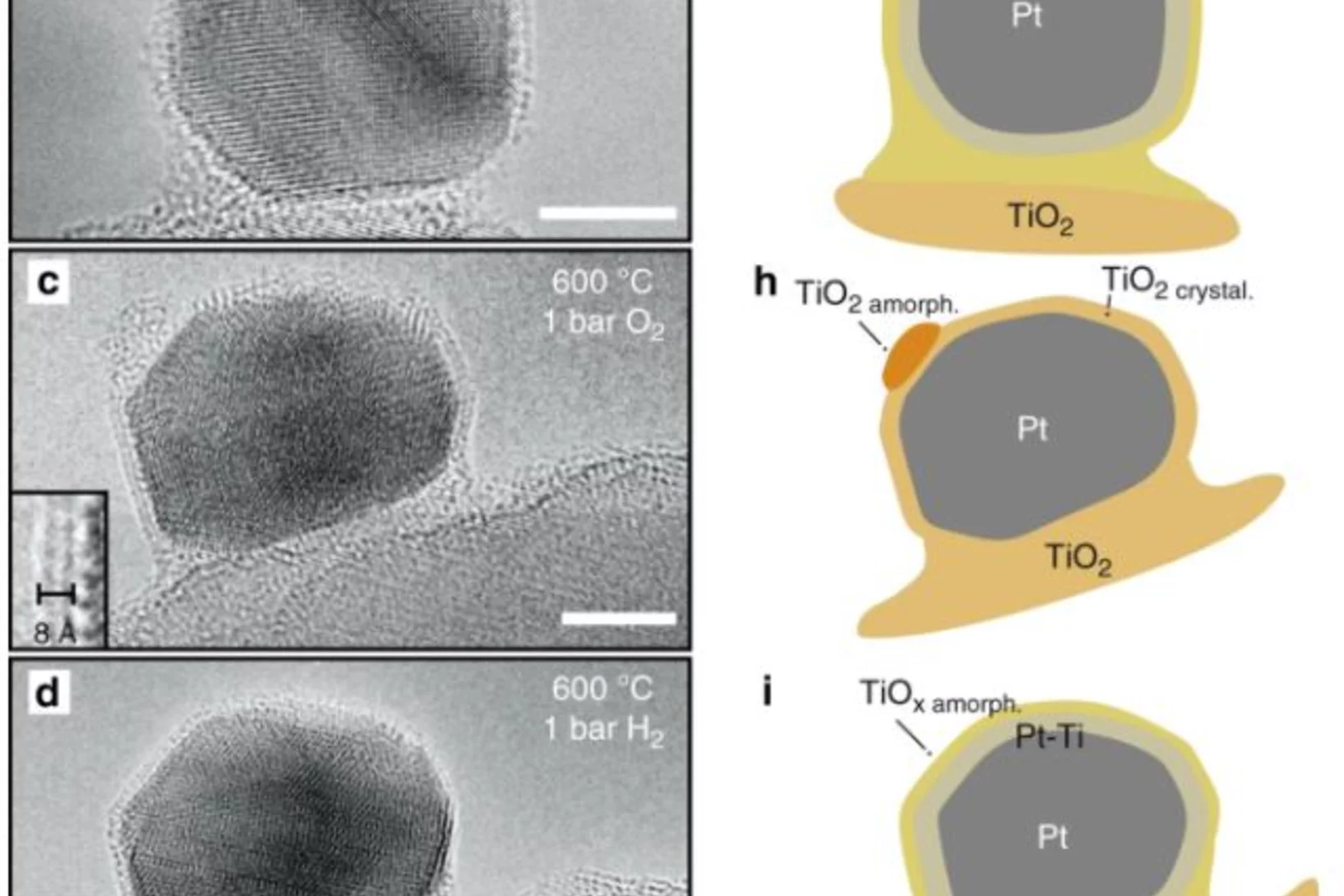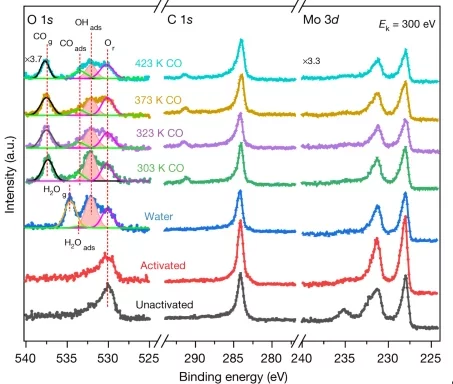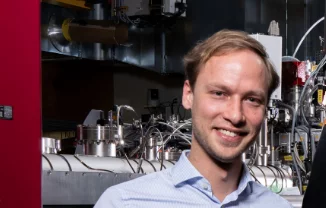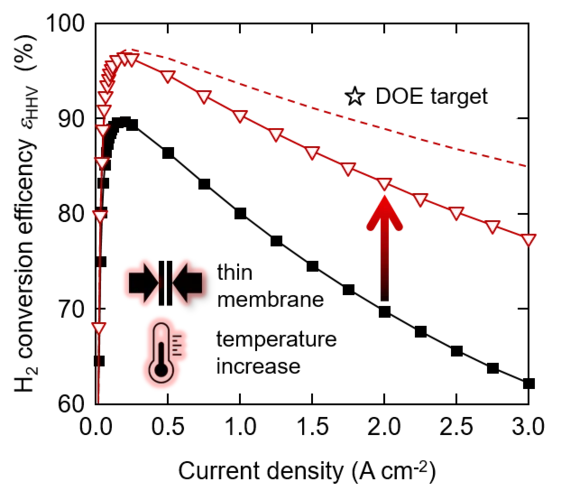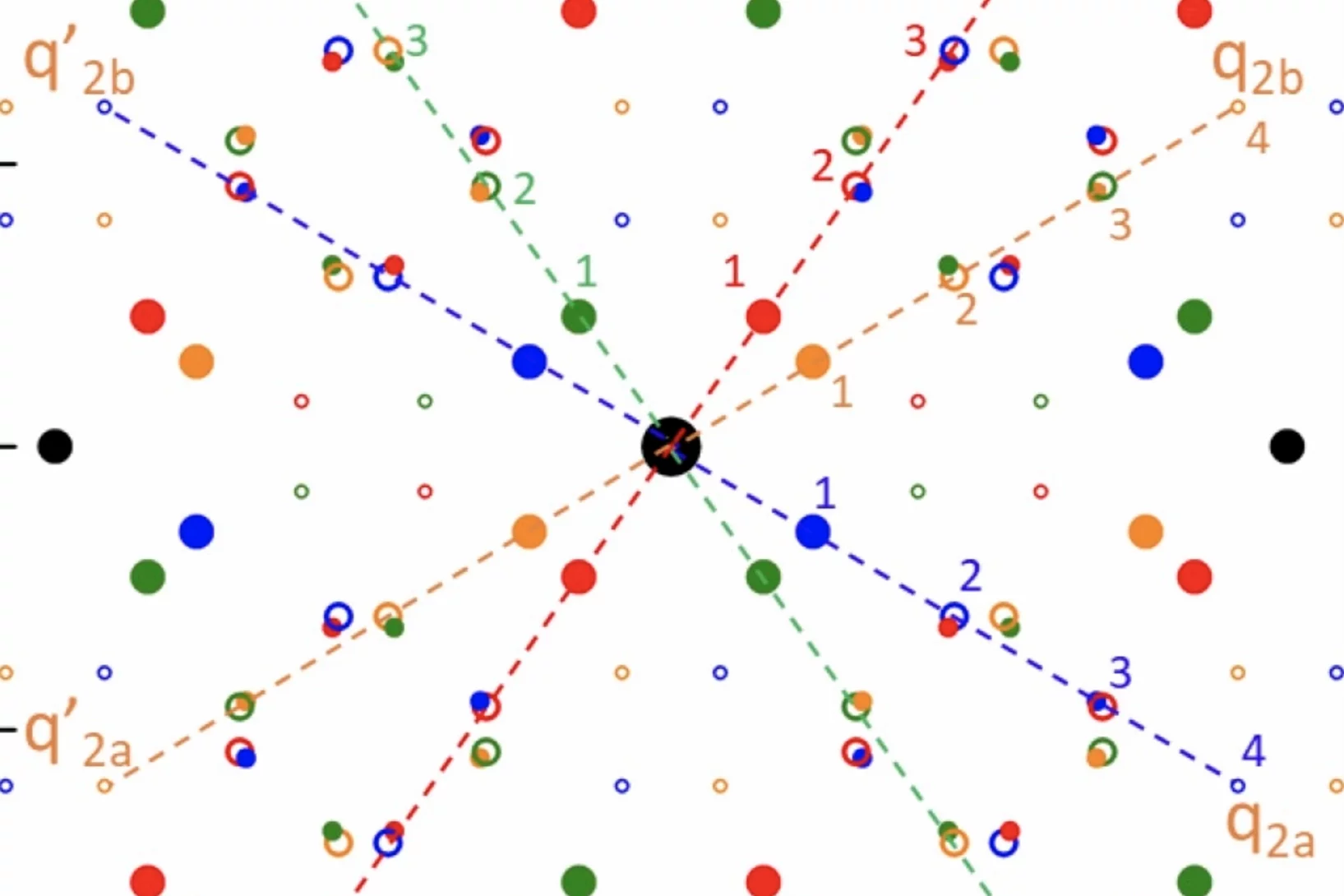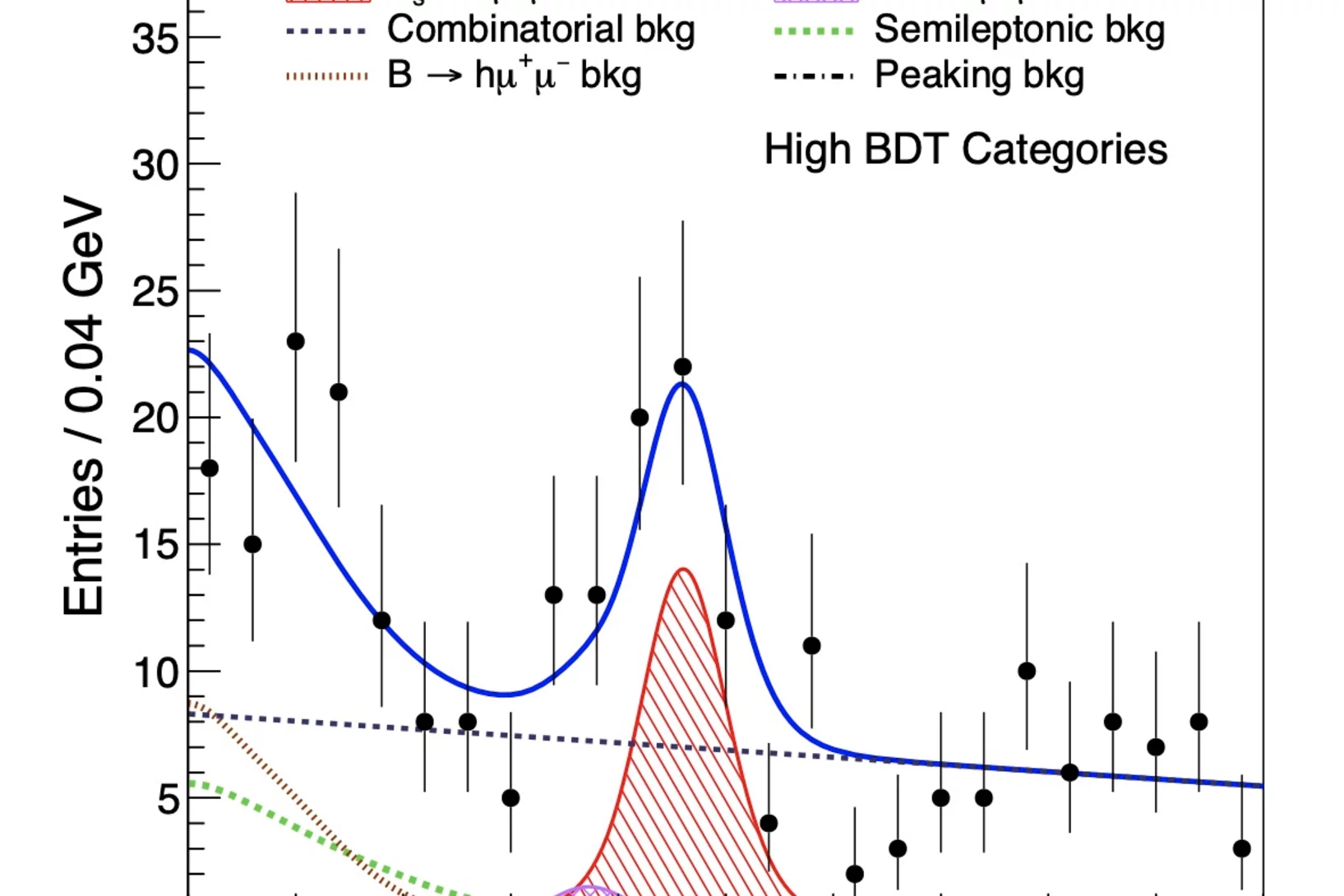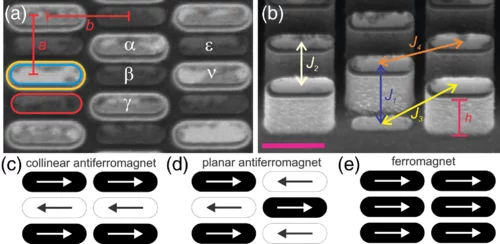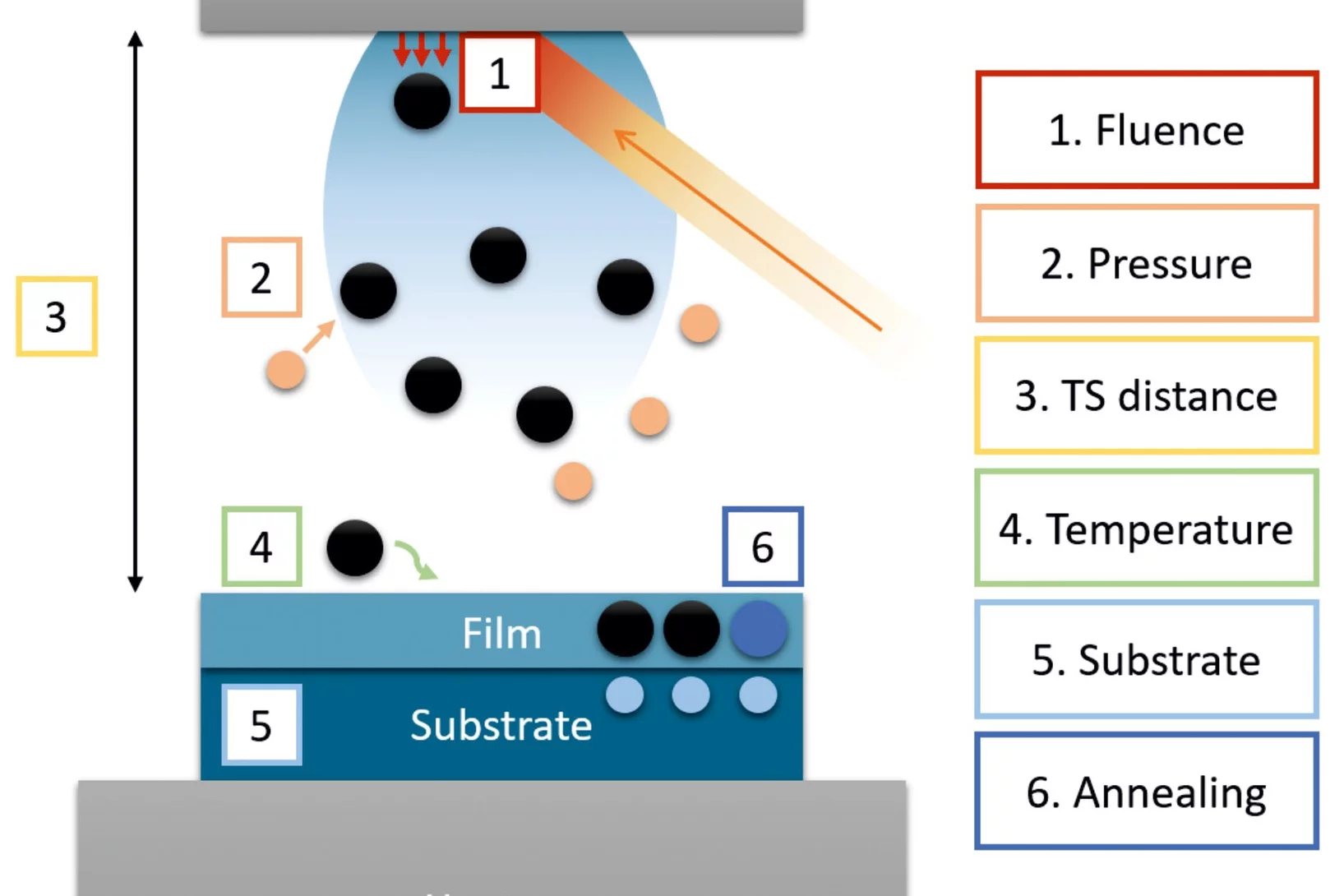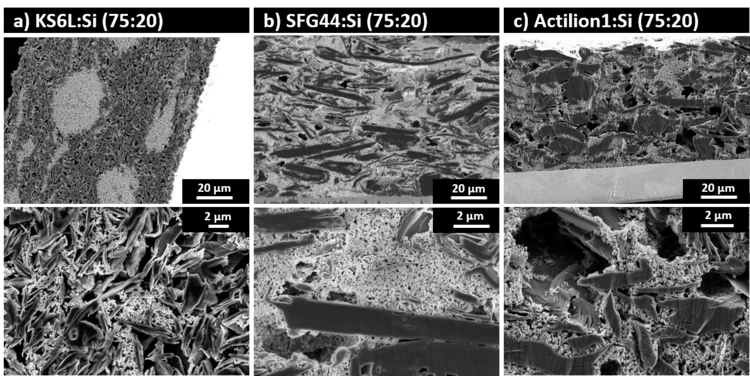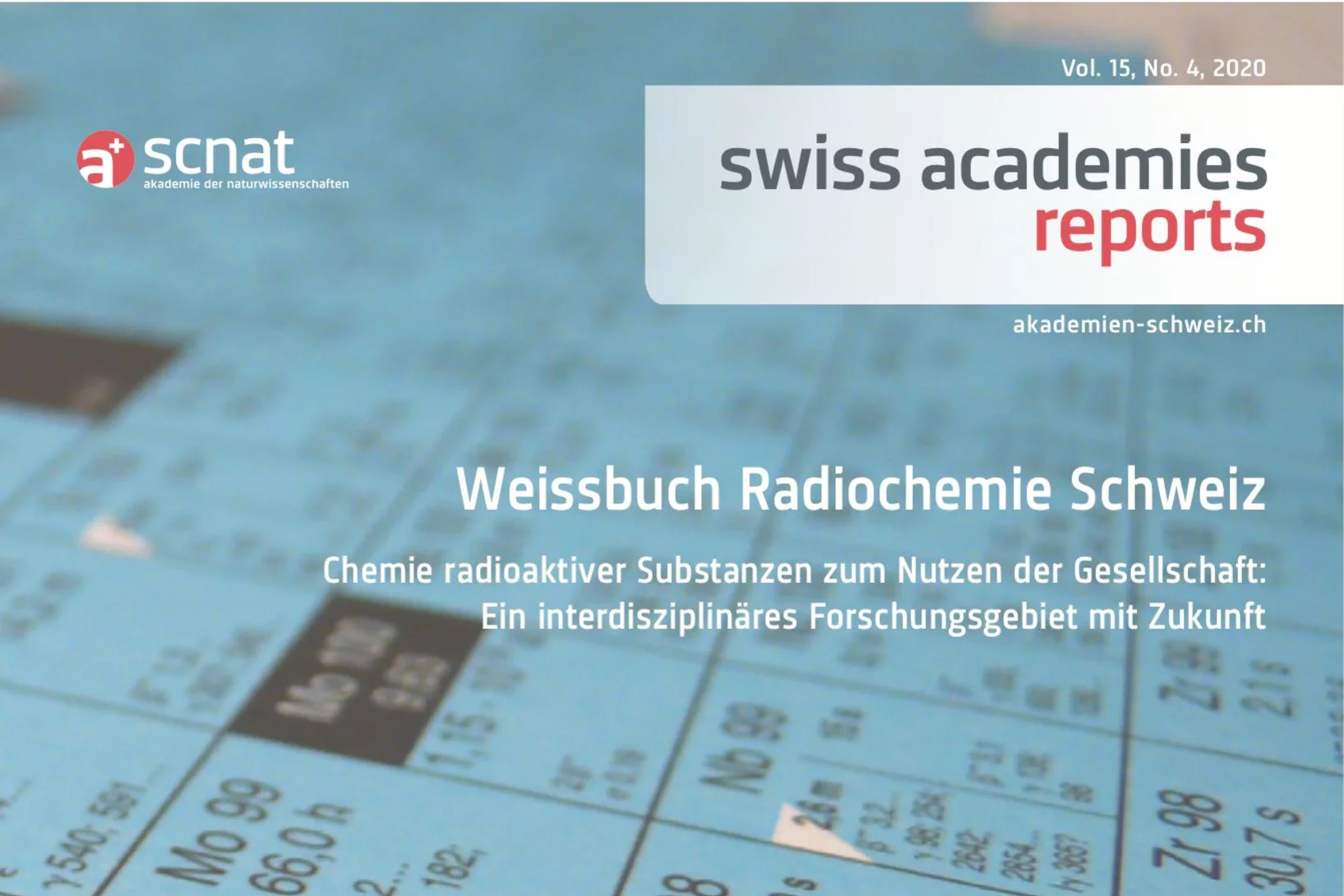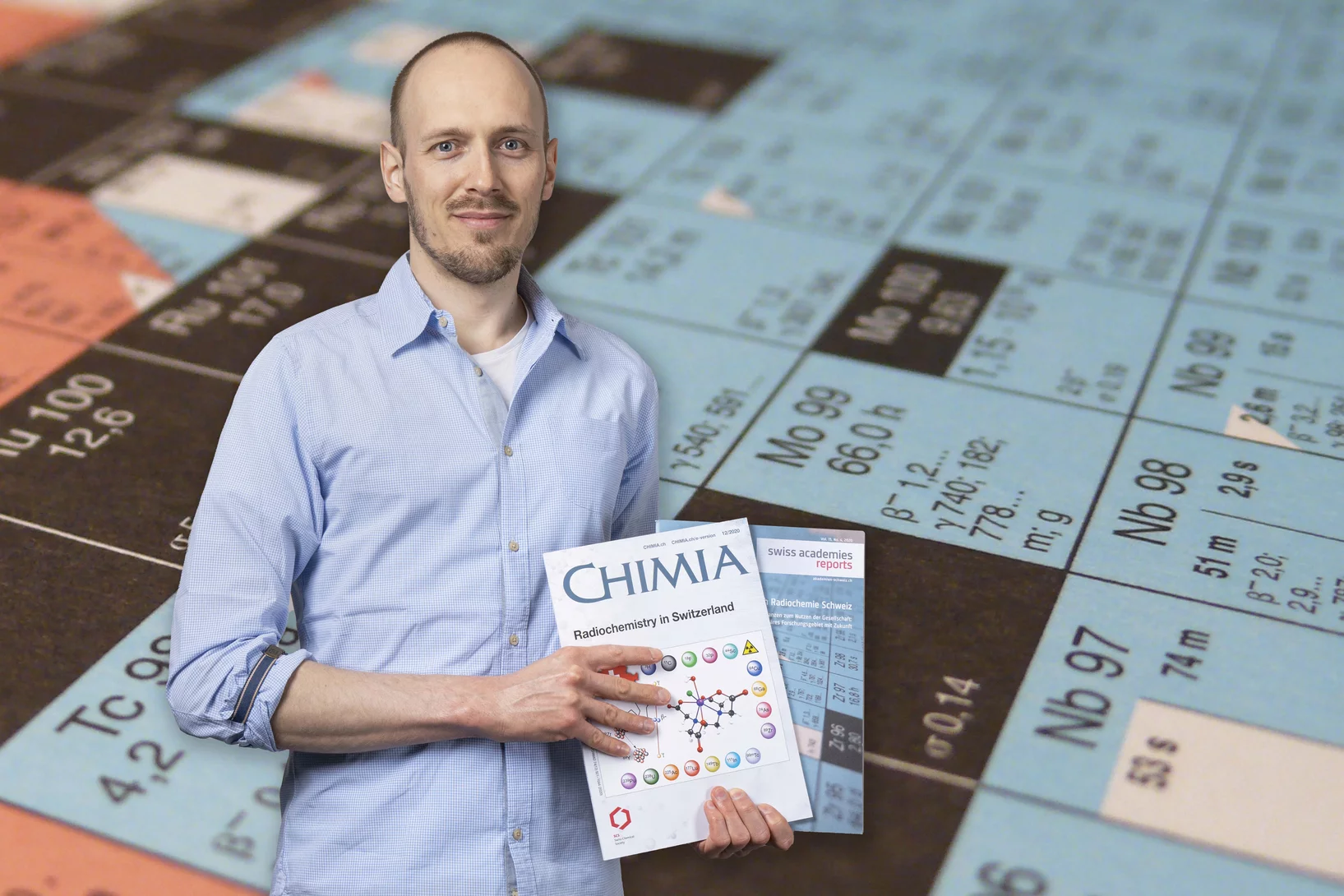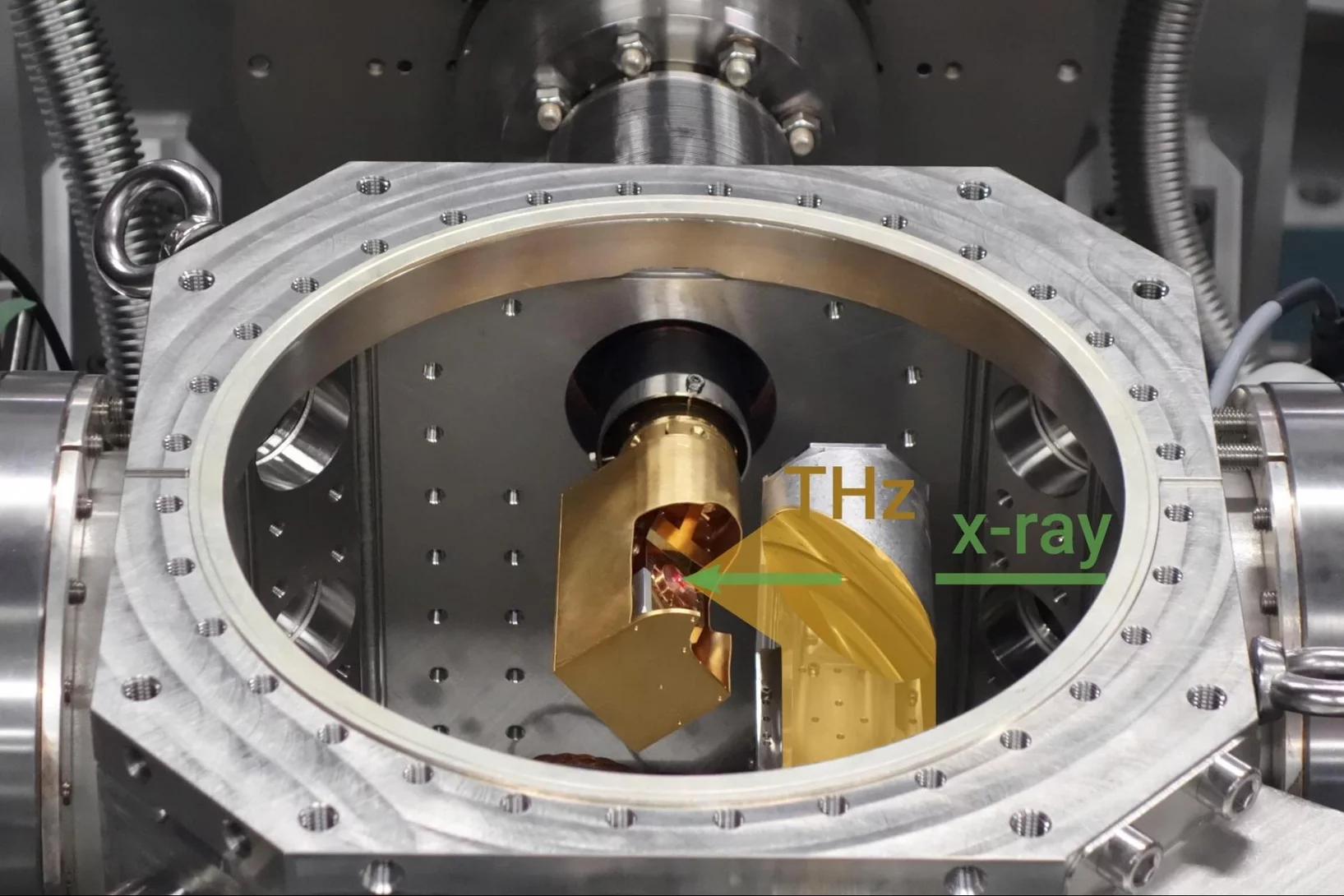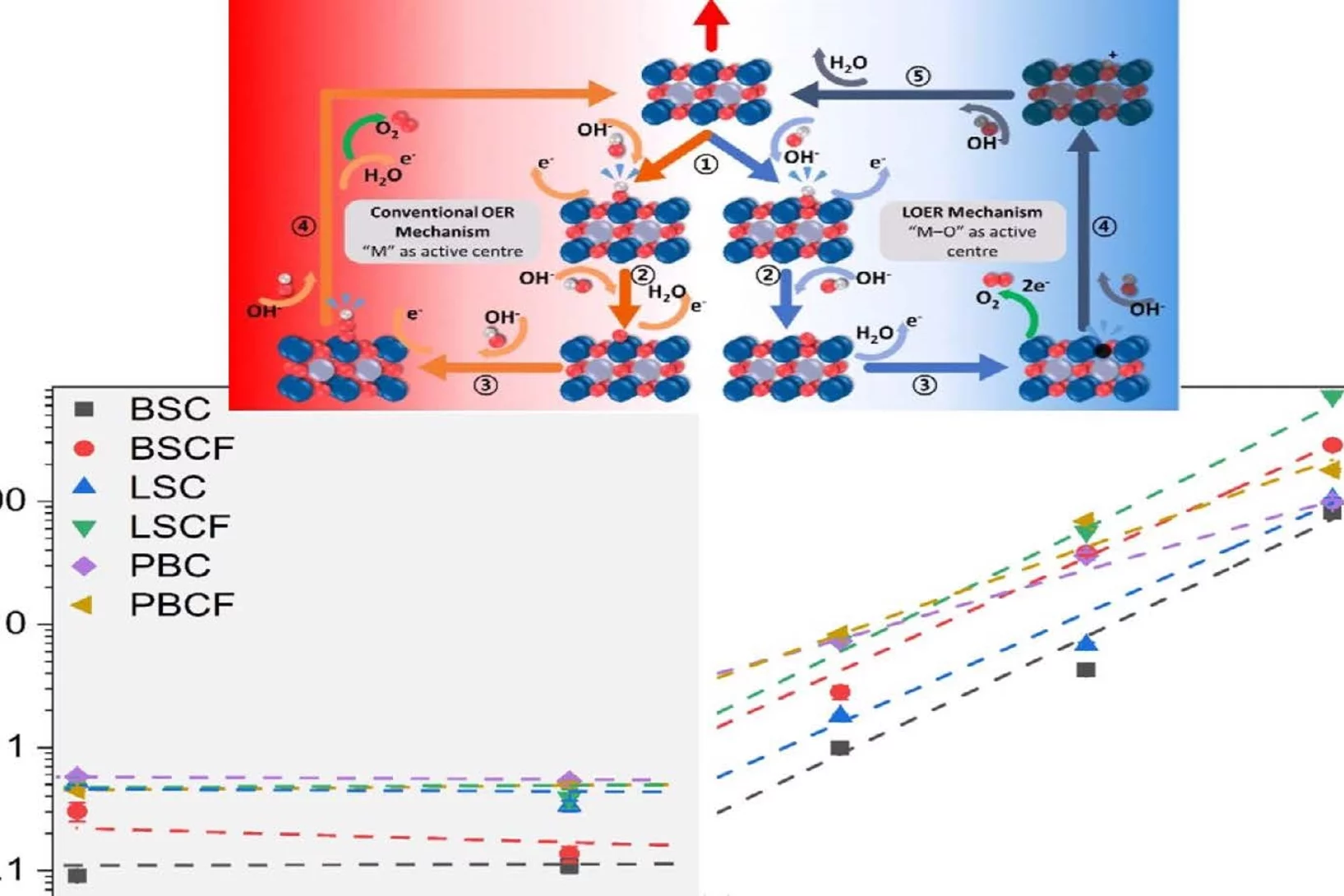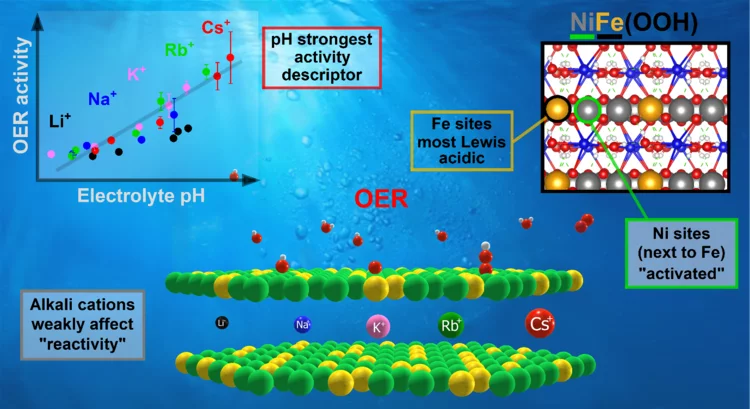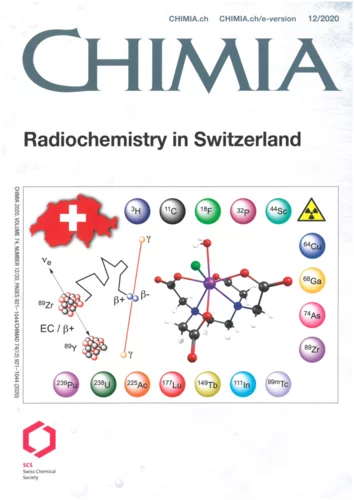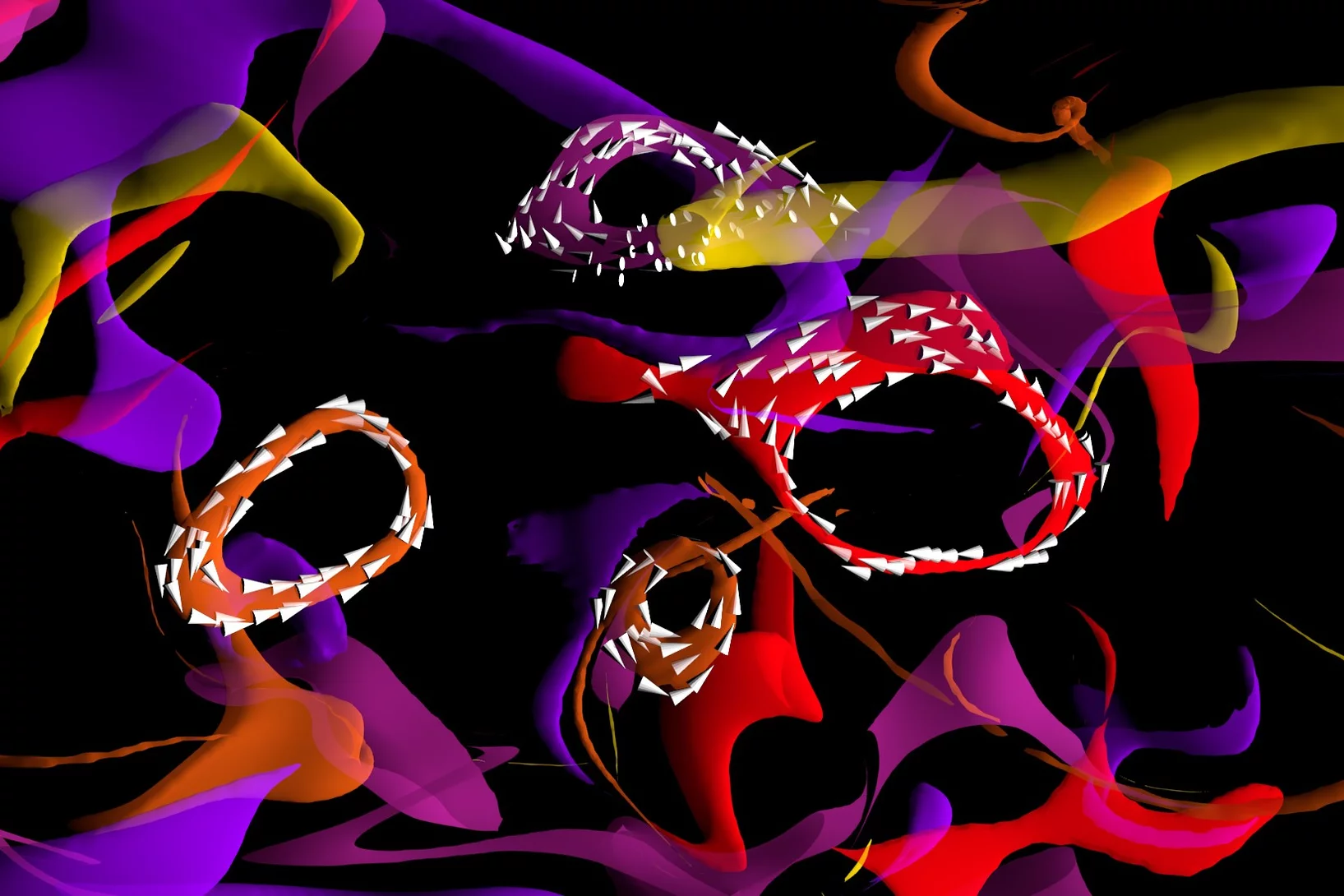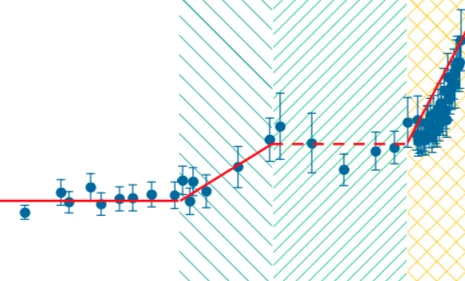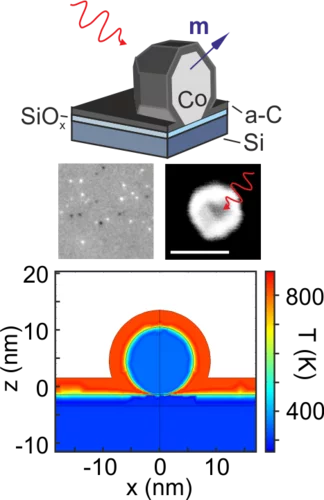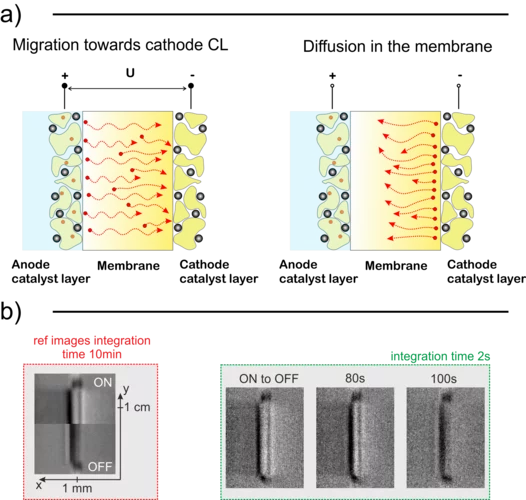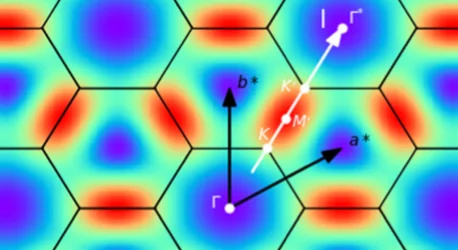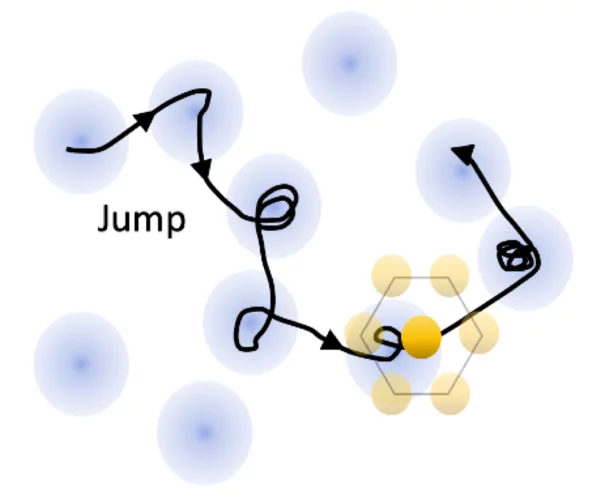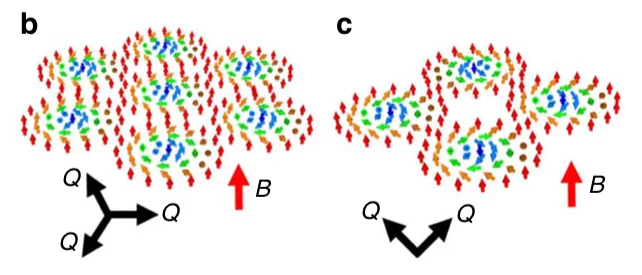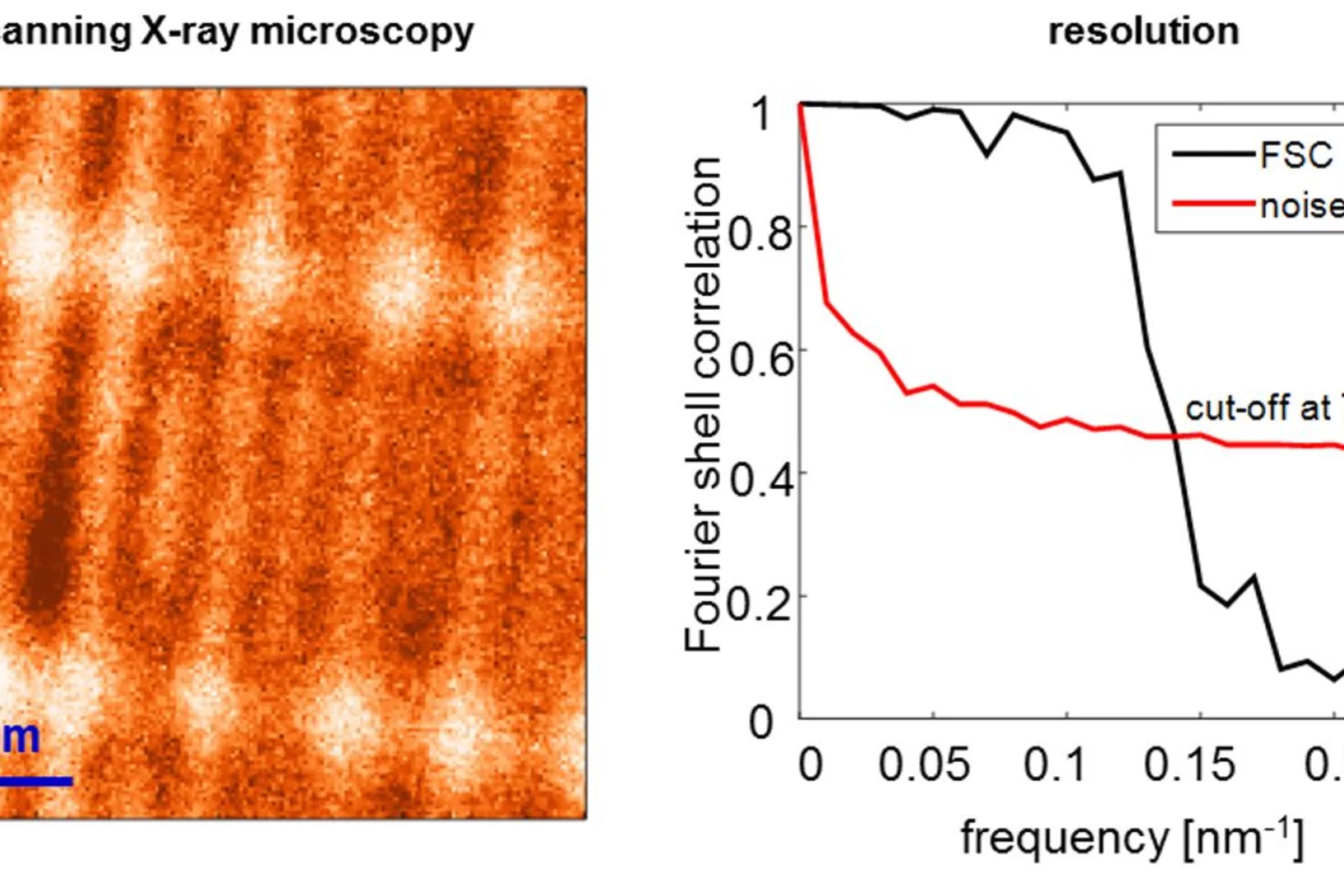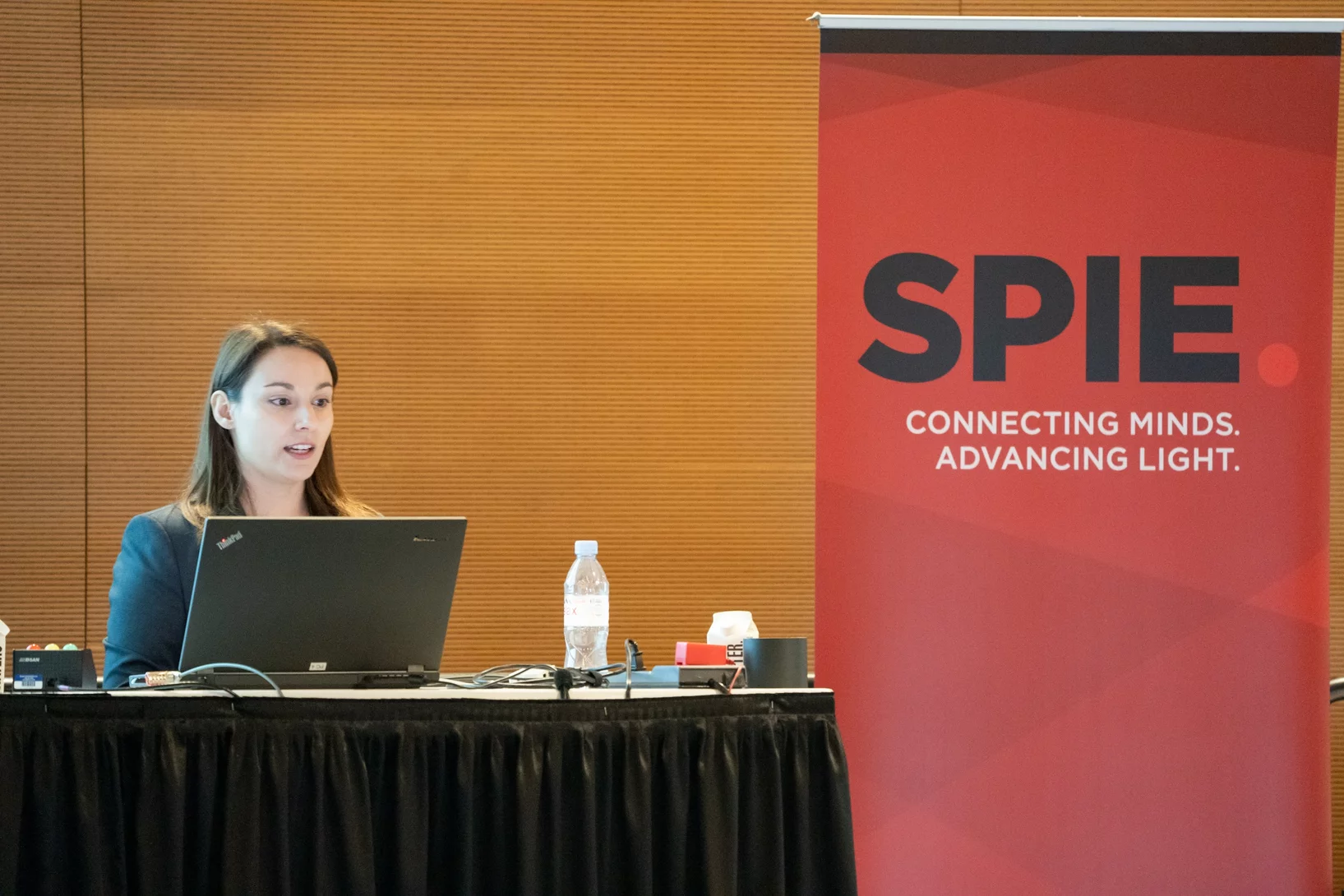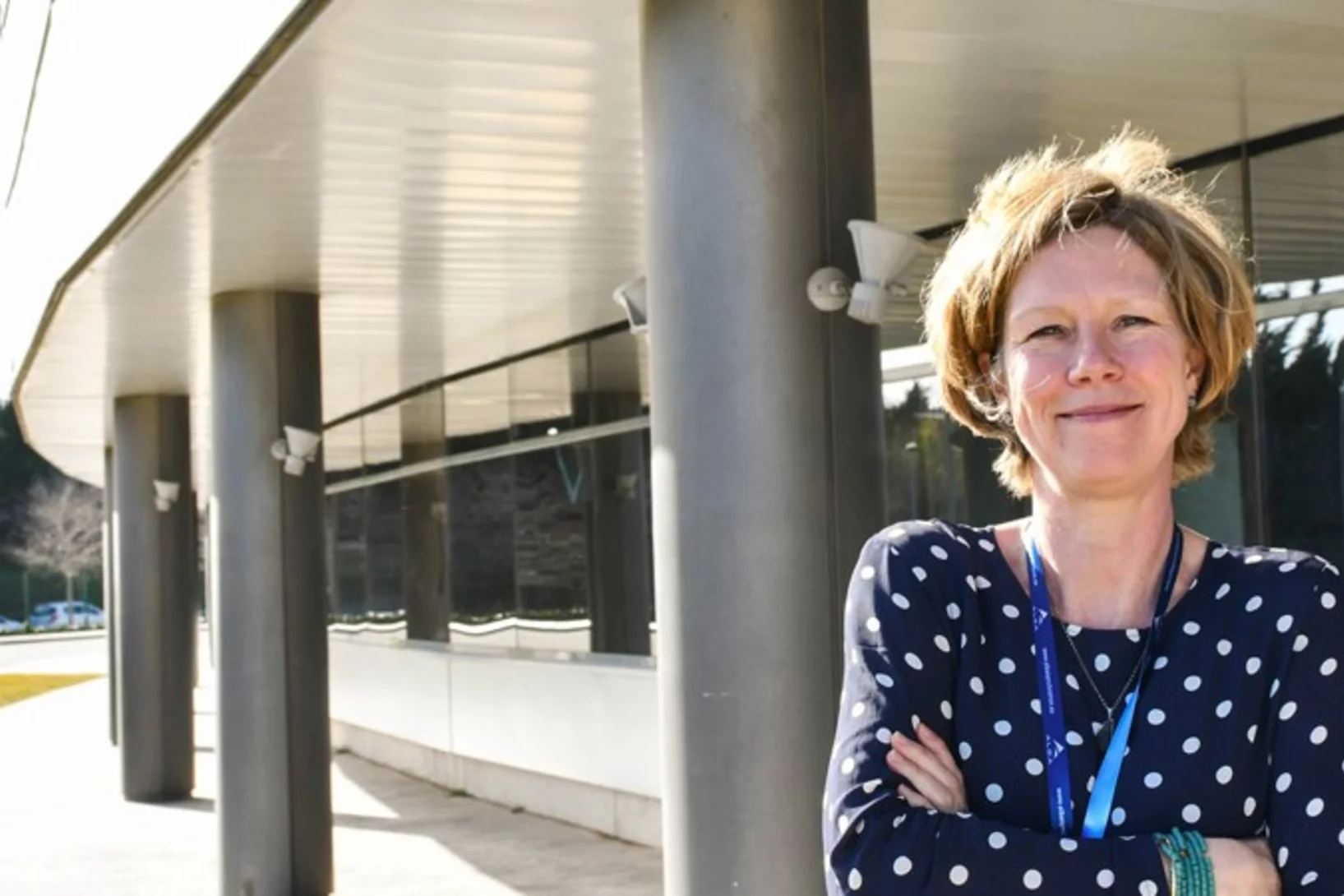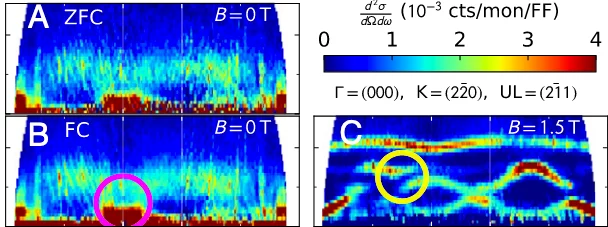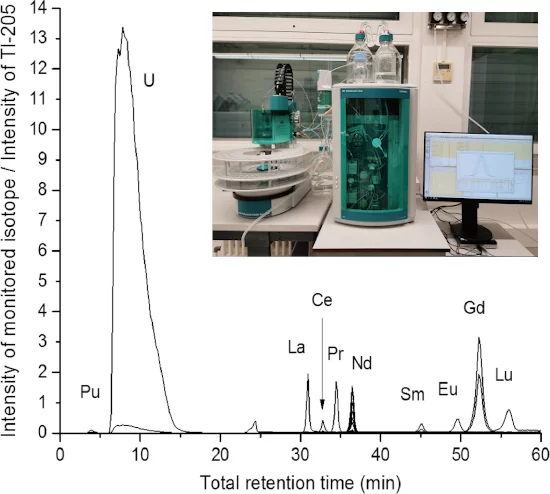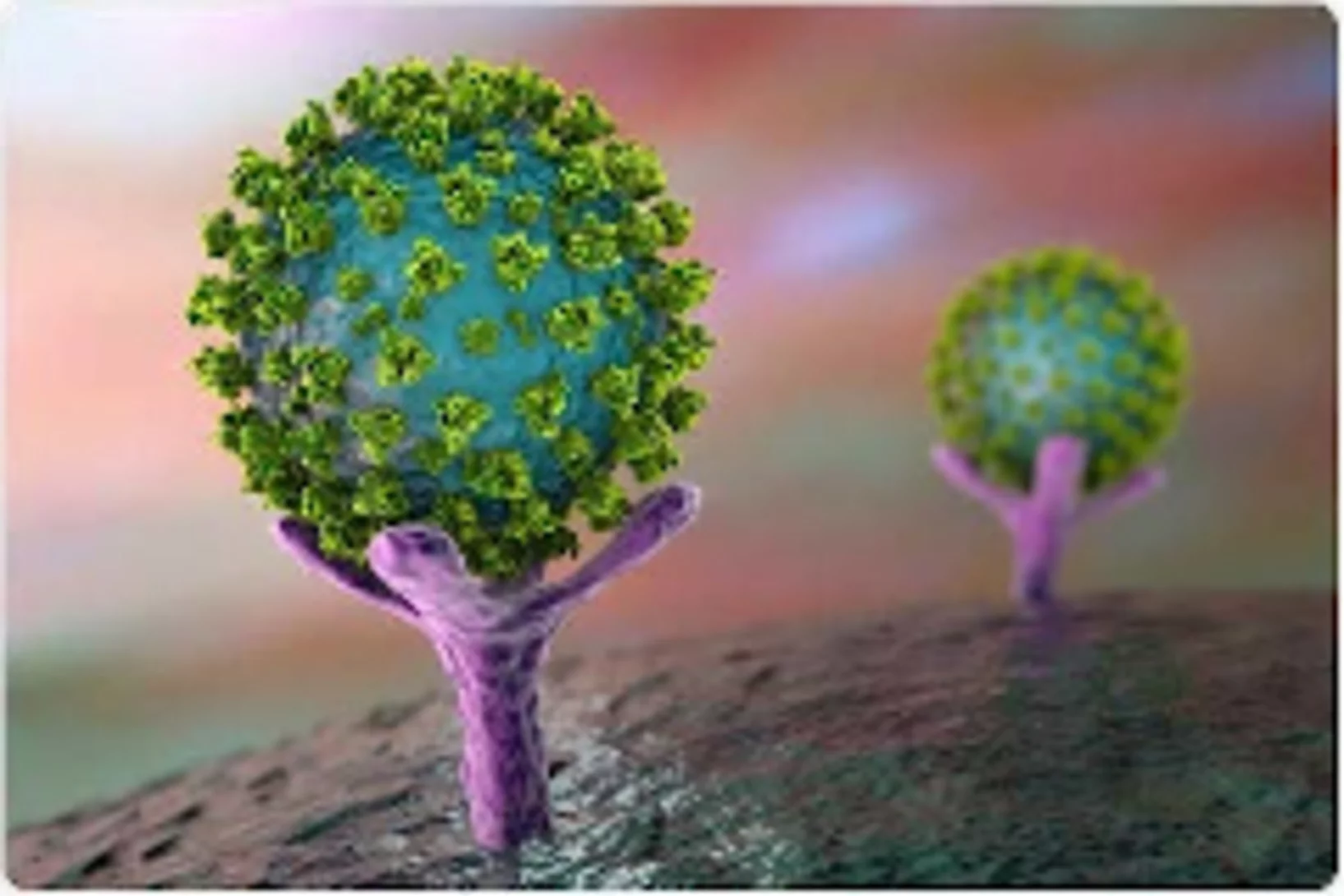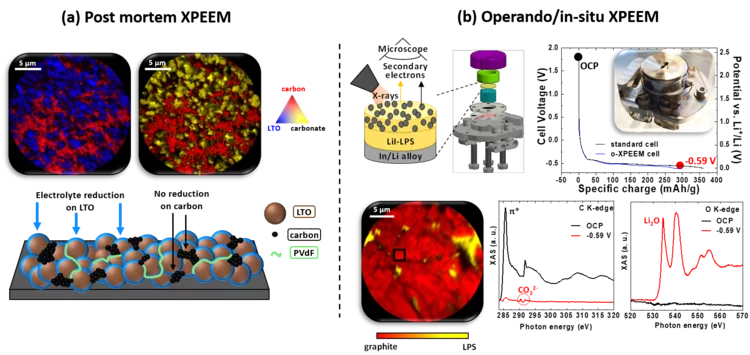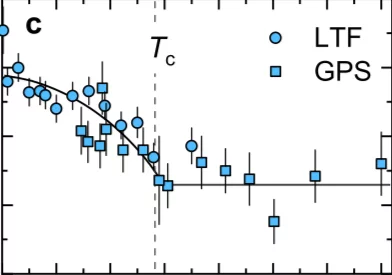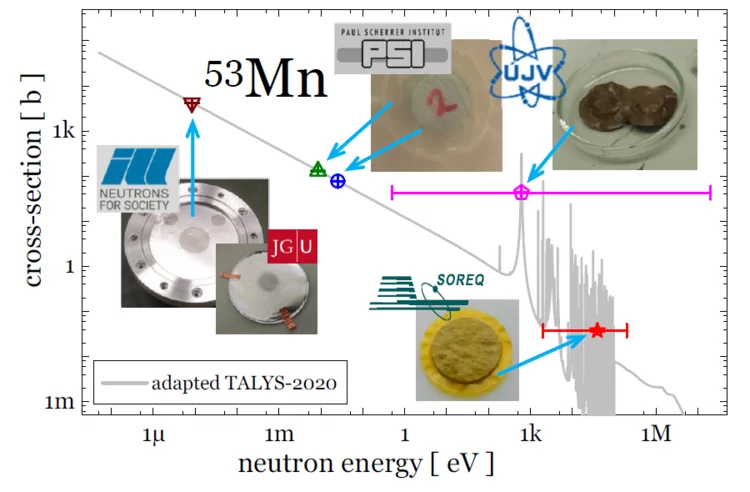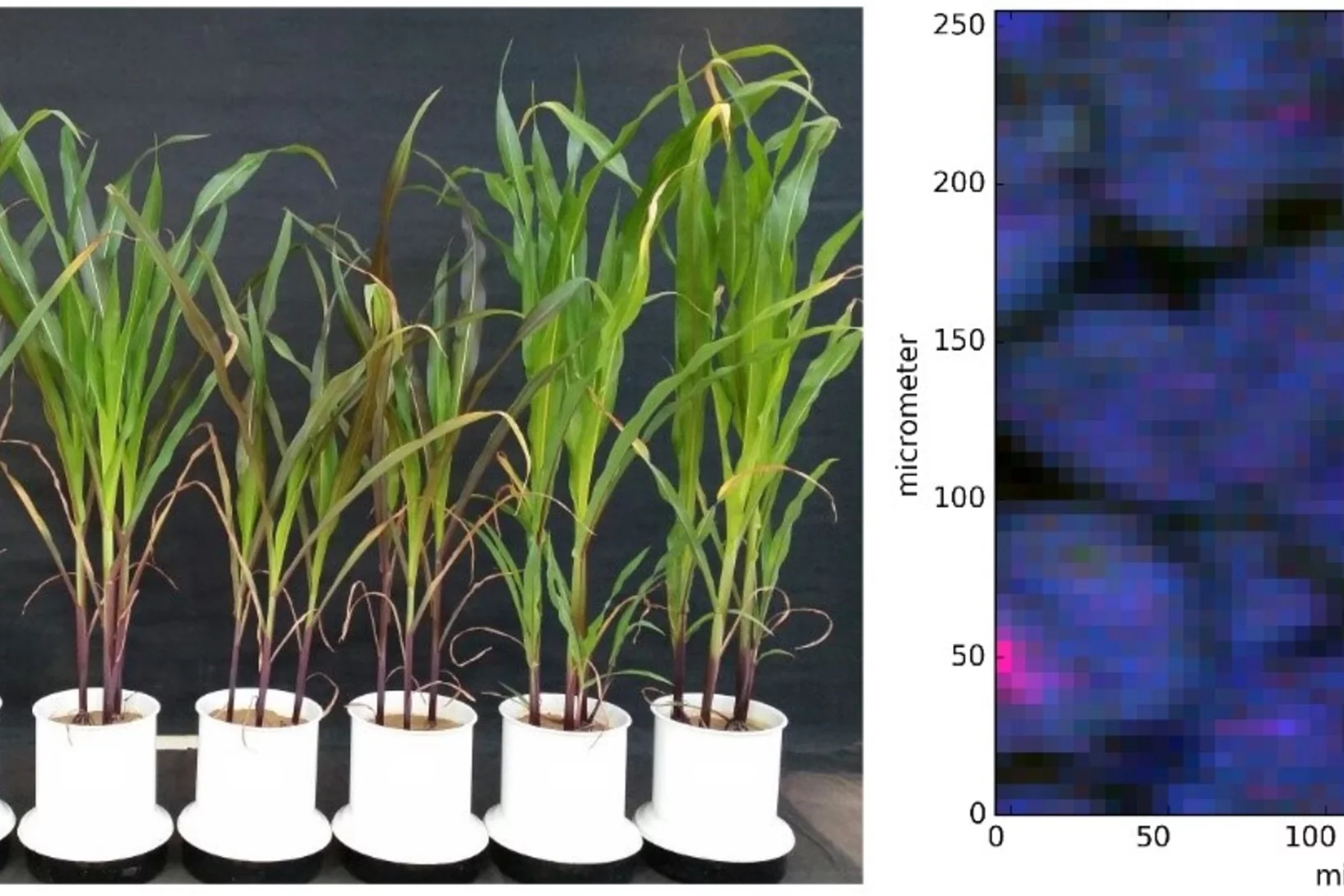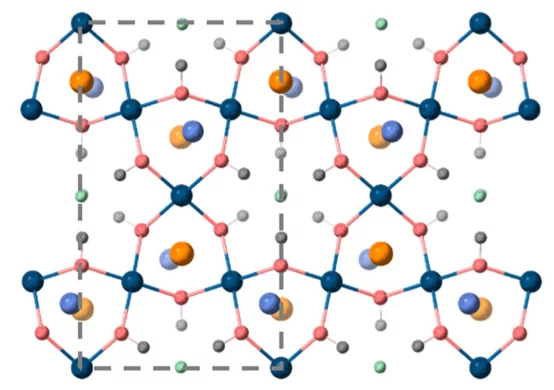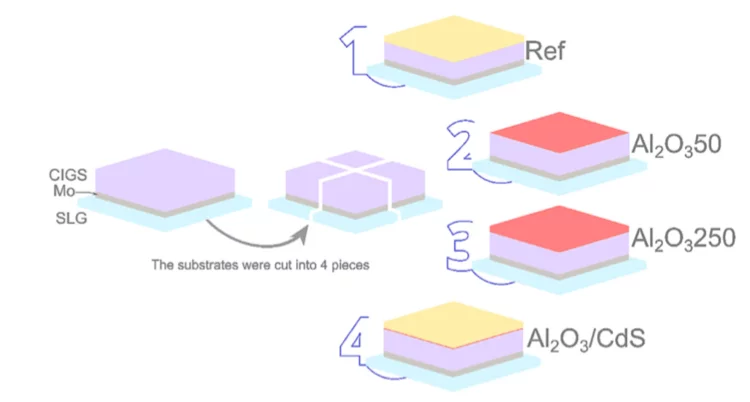Decomposing Magnetic Dark-Field Contrast in Spin Analyzed Talbot-Lau Interferometry: A Stern-Gerlach Experiment without Spatial Beam Splitting
We have recently shown how a polarized beam in Talbot-Lau interferometric imaging can be used to analyze strong magnetic fields through the spin dependent differential phase effect at field gradients. While in that case an adiabatic spin coupling with the sample field is required, here we investigate a nonadiabatic coupling causing a spatial splitting of the neutron spin states with respect to the external magnetic field. This subsequently leads to no phase contrast signal but a loss of interferometer visibility referred to as dark-field contrast.
Structural involvement in the melting of the charge density wave in 1T-TiSe2
The authors find using resonant and non-resonant x-ray diffraction on an x-ray free electron laser that the structural distortion and the underlying electronic structure of the charge density wave in TiSe2 show different energetics at ultrafast timescales. This indicates that the lattice distortion stabilizes the charge density wave.
Ultrafast calorimetry of deeply supercooled water
FEL-based ultrafast calorimetry measurements show enhancement and maximum in the isobaric specific-heat.
Clocking the movement of electrons inside an atom
Scientists pioneer an approach called self-referenced streaking, clocking Auger electrons with sub-femtosecond resolution. The breakthrough will unlock the broader potential for attosecond time resolution at X-ray free-electron lasers.
Novel X-band transverse deflection structure with variable polarization
The growing request for sophisticated electron beam manipulation techniques for the optimization of Free Electron Lasers (FELs) or novel acceleration techniques requires enhanced beam control capabilities and characterization. One of the most important challenge is the development of new diagnostic techniques able to characterize the longitudinal phase space of the beam, including spatial correlation terms, with a resolution in the range of a few tens of fs to sub-fs.
XPS allows in situ investigation of the solid-gas interface during a catalytic reaction
Platinum isolated atoms and clusters supported on molybdenum carbide have been characterized in situ by means of photoelectron spectroscopy. The presence of both species is essential to favor the stability, so that the catalysts displays high metal-normalized turnover number of 4,300,000 moles of hydrogen per mole of platinum during the water gas shift reaction.
Size of helium nucleus measured more precisely than ever before
In experiments at the Paul Scherrer Institute PSI, an international research collaboration has measured the radius of the atomic nucleus of helium five times more precisely than ever before. The researchers are publishing their results today in the journal Nature.
The dynamics of overlayer formation on catalyst nanoparticles and strong metal-support interaction
The editors at Nature Communications have put together an Editors’ Highlights webpage of recent research called “Catalysis” and chose to feature Arik Beck's et al. article, entitled “The dynamics of overlayer formation on catalyst nanoparticles and strong metal-support interaction”.
PUBLISHED IN NATURE: A stable low-temperature H2-production catalyst by crowding Pt on α-MoC
Platinum isolated atoms and clusters supported on molybdenum carbide have been extensively characterized. The presence of both species is essential to boost the stability, so that the catalysts displays high metal-normalized turnover number of 4,300,000 moles of hydrogen per mole of platinum
PSI Thesis Medal 2021 for pioneering Structural Biology at SwissFEL
Dr. Petr Skopintsev received PSI Thesis Medal 2021 for his work on the sodium pump KR2.
Clocking the movement of electrons inside an atom
Scientists pioneer an approach called self-referenced streaking, clocking Auger electrons with sub-femtosecond resolution. The breakthrough will unlock the broader potential for attosecond time resolution at X-ray free-electron lasers
Efficient Water Electrolysis at Elevated Temperature using Commercial Cell Components
Decarbonization of the energy system across different sectors using power-to-X concepts relies heavily on the availability of low-cost hydrogen produced from renewable power by water electrolysis. Polymer electrolyte water electrolysis (PEWE) is a promising technology for hydrogen (and oxygen) production for distributed as a well as centralized operation. The total cost of hydrogen is dominated by the electricity cost. Therefore, increase of conversion efficiency is pivotal in improving the commercial viability of electrolytically produced hydrogen. In this study, we investigate the prospects of improving conversion efficiency by reducing the membrane thickness from 200 to 50 micron and increasing the cell temperature from 60 to 120°C.
Interdependent scaling of long-range oxygen and magnetic ordering in nonstoichiometric Nd2NiO4.10
The interplay between oxygen and spin ordering for the low oxygen doped Nd2NiO4.10 has been investigated by single-crystal neutron diffraction. We find a coexistence of the magnetic order below TN with the 3D ordering of excess oxygen atoms, which has not been previously observed for the homologous nickelates. Moreover, the magnetic ordering modulation vectors are no longer independent and exactly follow the modulation vectors of the oxygen ordering.
Results on BS0 →μ+μ- decays with the CMS experiment
Results are reported on BS0 →μ+μ- decays using 61 fb-1 of proton-proton collision data obtained in 2011-2016 with the CMS experiment at the LHC (CERN). In the standard model (SM) of particle physics this decay can be precisely calculated with small theoretical uncertainties, making it an excellent probe for testing the limits of the SM. The branching fraction BF(BS0 →μ+μ-)=(2.9 ± 0.7) x 10-9 is measured with a statistical significance of 5.6 standard deviations. In addition, the effective lifetime of this decay is measured as 𝜏𝜇𝜇=1.70+0.61−0.44
ps. Both results are in good agreement with the SM prediction. In comparison to the previous analysis, a much improved muon identification algorithm significantly increased the purity and strongly reduced the background. As a consequence, the measurement of BF(B0 →μ+μ-) < 3.6 x 10-10 at 95% CL is no longer in tension to the SM, but fully compatible with it.
Geometrical Frustration and Planar Triangular Antiferromagnetism in Quasi-Three-Dimensional Artificial Spin Architecture
We present a realization of highly frustrated planar triangular antiferromagnetism achieved in a quasi-three-dimensional artificial spin system consisting of monodomain Ising-type nanomagnets lithographically arranged onto a deep-etched silicon substrate. We demonstrate how the three-dimensional spin architecture results in the first direct observation of long-range ordered planar triangular antiferromagnetism, in addition to a highly disordered phase with short-range correlations, once competing interactions are perfectly tuned. Our work demonstrates how escaping two-dimensional restrictions can lead to new types of magnetically frustrated metamaterials.
Pulsed Laser Deposition as a Tool for the Development of All Solid-State Microbatteries
All-solid-state lithium ion batteries (LIB) are currently the most promising technology for next generation electrochemical energy storage. Many efforts have been devoted in the past years to improve performance and safety of these devices. Nevertheless, issues regarding chemical and mechanical stability of the different components still hinder substantial improvements. Pulsed laser deposition (PLD) has proved to be an outstanding technique for the deposition of thin films of materials of interest for the fabrication of LIB. Thanks to its versatility and possible fine tuning of the thin film properties, PLD promises to be a very powerful tool for the fabrication of model systems which would allow to study in detail material properties and mechanisms contributing to LIB degradation. Nevertheless, PLD presents difficulties in the deposition of LIB components, mainly due to the presence of elements with large difference of atomic mass in their chemical composition. In this review, we report the main challenges and solution strategies used for the deposition through PLD of complex oxides thin films for LIB.
Graphite Anodes with Si as Capacity-Enhancing Electrode Additive
Silicon is a long-standing candidate for replacing graphite as the active material in negative electrodes for Li-ion batteries, due to its significantly higher specific capacity. However, Si suffers from rapid capacity loss, as a result of the large volume expansion and contraction during lithation and de-lithiation. As an alternative to pure Si electrodes, Si could be used as a capacity-enhancing additive to graphite electrodes.
Weissbuch Radiochemie Schweiz
In December 2020, the Swiss Academy of Sciences (SCNAT) published its white book on radiochemical education in Switzerland. The report was authored under the lead of Prof. Dr. Roger Alberto (University of Zurich), Dr. Mario Burgener (Spiez Laboratory), and Prof. em. Dr. Heinz W. Gäggeler (University of Bern/Paul Scherrer Institute) and comprises contributions from many experts on the topic from various institutions throughout Switzerland. The white book highlights the imminent loss of experts in the field of radiochemistry and provides solutions to counteract this development.
Radiochemistry at ETH Zurich
As of December 10, 2020, the ETH Zurich appointed PSI’s Prof. Dr. Patrick Steinegger as assistant professor of radiochemistry (tenure track). Thus, the ETH domain took first counter measures against the imminent loss of radiochemical expertise in Switzerland, emphasized in the “Weissbuch Radiochemie Schweiz” by the Swiss Academy of Sciences (SCNAT). Furthermore, the December issue of CHIMIA (Swiss Chemical Society) invited to present the diverse radiochemical activities throughout the country.
Long-range coherent dynamics of bound electrons in a solid
Ultrafast long-range coherent dynamics in electronic structure excited by THz pulses and studied using free electron laser based resonant X-ray diffraction.
Seven years SCCER Mobility
Synthesis book reviews history, milestones and achievements of the center
Oxygen Evolution Reaction Activity and Underlying Mechanism of Perovskite Electrocatalysts at Different pH
PSI researchers have studied the how the electrolyte pH values influence the oxygen evolution reaction (OER) activity and stability of different promising perovskite oxide catalysts for application as anodic electrodes in alkaline water electrolyzers. The OER activity and stability decreased decreasing the electrolyte pH values. By combining electrochemical studies and operando X-ray absorption spectroscopy measurements, it has been suggested that different reaction mechanisms dominate in alkaline and near-neutral electrolyte pH region.
Key activity descriptors of nickel-iron oxygen evolution electrocatalysts in the presence of alkali metal cations
Ni-Fe oxyhydroxide is among the most active oxygen evolution electrocatalysts. Electrolyte alkali metal cations modify the activity and reaction intermediates, however, the exact mechanism is at question due to unexplained deviations from the cation size trend. Our X-ray absorption spectroelectrochemical results show that the OER activity follows the variations in .electrolyte pH rather than a specific cation. Our DFT-based reactivity descriptors confirm the conclusions of an indirect pH effect.
Sustainability Assessment of Potential Areas for Deep Geothermal Energy Systems in Switzerland
In this study, scientists from the Paul Scherrer Institute (PSI) assessed the suitability of potential areas for Deep Geothermal Energy (DGE) systems in Switzerland with regard to their sustainability.
CHIMIA: Radiochemistry in Switzerland
The December issue of CHIMIA of the Swiss Chemical Society (SCS) focused on the radiochemical activities throughout Switzerland. Scientists of the Laboratory of Radiochemistry contributed with a number of articles ranging from topics of fundamental sciences to applied research, thereby reflecting on the diverse projects carried out in our laboratory.
Magnetic vortices come full circle
The first experimental observation of three-dimensional magnetic ‘vortex rings’ provides fundamental insight into intricate nanoscale structures inside bulk magnets, and offers fresh perspectives for magnetic devices.
Ruzicka Prize
The Ružička Prize 2020 goes to Dr. Patrick Hemberger (PSI) for his research on understanding the mechanisms of catalytic fast pyrolysis by unveiling reactive intermediates in heterogeneous catalysts.
Quantum spin-liquid states in an organic magnetic layer and molecular rotor hybrid
A better understanding of quantum spin liquids (QSLs), where spin dimer configurations are fluctuating even at the low- est temperatures, could be of use in quantum information, in superconducting or other technologies. This macroscopic collective state typically arises from geometrical frustration or low dimensionality. In the layered EDT-BCO, we report a QSL state, which is generated, on different bases, with the intrinsic disorder.
Single femtosecond laser pulse excitation of individual cobalt nanoparticles
The interaction of light and magnetism at the nanoscale is a topic of fundamental interest and with potential impact to future spintronics applications. in this work we address theoretically and experimentally the effect of femtosecond laser pulse excitation on the magnetic, structural, and chemical stability of individual magnetic cobalt nanoparticles including the role of the substrate or matrix. Eventually, we discuss possible pathways to achieve laser-induced magnetic switching in individual nanostructures.
This work has been highlighted as "Editors' Suggestion" in Physical Review B.
Analysis of cation contamination of polymer electrolyte water electrolysers (PEWEs)
With the help of in situ PEWE regeneration methods, we can potentially enable the treatment of degraded cells without the necessity of stack disassembly, saving operation costs of the plant. In this context, we observed the movement of cations in a PEWE cell using neutron imaging and compared it with a model. This model is expected to be useful for the early detection of cation contamination problems in PEWEs, and the monitoring of in situ regeneration.
Observation of plaquette fluctuations in the spin-1/2 honeycomb lattice
Quantum spin liquids are materials that feature quantum entangled spin correlations and avoid magnetic long-range order at T =0 K. Particularly interesting are two-dimensional honeycomb spin lattices where a plethora of exotic quantum spin liquids have been predicted. Here, we experimentally study an effective S = 1/2 Heisenberg honeycomb lattice with competing nearest and next-nearest-neighbour interactions.
Revealing Creep Motion of a Skyrmion Lattice at Ultra-Low Current Densities
Magnetic skyrmions are well-suited for encoding information because they are nano-sized, topologically stable, and only require ultra-low critical current densities jc to depin from the underlying atomic lattice. Above jc, skyrmions exhibit well-controlled motion, making them prime candidates for race-track memories. In thin films thermally-activated creep motion of isolated skyrmions was observed below jc as predicted by theory.
Particle-size dependent structural transformation of skyrmion lattice
Magnetic skyrmion is a topologically protected particle-like object in magnetic materials, appearing as a nanometric swirling spin texture. The size and shape of skyrmion particles can be flexibly controlled by external stimuli, which suggests unique features of their crystallization and lattice transformation process. Here, we investigated the detailed mechanism of structural transition of skyrmion lattice (SkL) in a prototype chiral cubic magnet Cu2OSeO3, by combining resonant soft X-ray scattering (RSXS) experiment and micromagnetic simulation...
World Record: 7 nm Resolution in Scanning Soft X-ray Microscopy
During the past decade, scientists have put high effort to achieve sub-10 nm resolution in X-ray microscopy. Recent developments in high-resolution lithography-based diffractive optics, combined with the extreme stability and precision of the PolLux and HERMES scanning X-ray microscopes, resulted now in a so far unreached resolution of seven nanometers in scanning soft X-ray microscopy. Utilizing this highly precise microscopy technique with the X-ray magnetic circular dichroism effect, dimensionality effects in an ensemble of interacting magnetic nanoparticles can be revealed.
Finalist of the Photronics Best Student Award
Ricarda Nebling, PhD student at LMN, received a prize at the SPIE Extreme Ultraviolet Conference 2020 for her contribution: “Effects of the illumination NA on EUV mask inspection with coherent diffraction imaging”.
BEATS Project
Mirjam van Daalen, chair of the BEATS Steering Committee
Multiphase magnetism in Yb2Ti2O7
Quantum materials have properties that defy conventional theories of solids. Explaining these unusual properties is a frontier in physics, which promises both technological applications and fundamentally new states of matter. Yb2Ti2O7 is a center of attention in this work. While it becomes ferromagnetic at very low temperature, its excitation spectrum resembles that of a quantum spin liquid. We show using neutron scattering ...
New element and speciation specific analytical options at AHL
The Hot Laboratory division (AHL) within PSI’s Nuclear Energy and Safety (NES) division continually upgrades and advances its analytical infrastructure to provide cutting-edge scientific service to PSI’s researchers and industrial customers. A new, fully automatable and highly flexible Ion Chromatograph (IC) furthers AHL’s efforts in sample miniaturization and extends the spectrum of destructive analytical capabilities to element and speciation specific analyses. With the new IC and its modern ICP-MS (Inductively Coupled Plasma Mass Spectrometry) facilities, AHL offers innovative scientific options for nuclear and general research. Moreover, speciation analyses by IC-ICP-MS for polyvalent inorganic water pollutants such as Cr or As and the acquisition of a new ICP-OES system (Inductively Coupled Plasma Optical Emission Spectrometry) enable future autonomy in wastewater management.
Aerosol distribution in rooms and the importance of proper ventilation
Urs Baltensperger explains the background why it is absolutely necessary to wear masks in order to reduce the risk of beeing infected with Covid-19.
In the following you find the presentation and summary
Post mortem/operando XPEEM: for studying the surface of single particle in Li-ion battery electrodes
X-ray photoemission electron microscopy (XPEEM) with its excellent spatial resolution is a well-suited technique to elucidate the complex electrode-electrolyte interface reactions in Li-ion batteries. It provides element-specific contrast images and enables the acquisition of local X-ray absorption spectra on single particles. Here we demonstrate the strength of post mortem measurements and we show the first electrochemical cell dedicated for operando experiments in all-solid-state batteries.
Atelier deliverable nr. D9.1 Draft released
Draft of the Deliverable nr. D9.1 on "Repository of Definitions of terms, key characteristics archetypes and a set of KPIS" for the H2020 Atelier project
Re(1−x)Mox as an ideal test case of time-reversal symmetry breaking in unconventional superconductors
Non-centrosymmetric superconductors (NCSCs) are promising candidates in the search for unconventional and topological superconductivity. The α-Mn-type rhenium-based alloys represent excellent examples of NCSCs, where spontaneous magneticfields, peculiar to time-reversal symmetry (TRS) breaking, have been shown to develop in the superconducting phase. By converse, TRS is preserved in many other isostructural NCSCs, thus leaving the key question about its origin fully open. Here, we consider ...
Young Scientist Prize 2020 of the Swiss Neutron Science Society
The Swiss Neutron Science Society as one of the representatives of the neutron scatterers in Switzerland honors each year young scientist in recognition of a notable scientific achievement in the form of a PhD thesis or to a nominee with an exceptional track record in neutron science.
In 2020 one of the prizes sponsored by SwissNeutronics was awarded to Jiri Ulrich (LRC/PSI) for his doctoral thesis on “High precision nuclear data of Mn-53 for astrophysics and geosciences”.
COVID-19 - travel assistance websites launched
The Bio Nano spinout of Prof. Aeppli has launched new travel assistance websites that provide continually updated information on restrictions such as multi-day quarantines imposed on travel between countries, together with the latest pandemic predictions so that travellers can make informed decisions.
Phosphorus recovery from wastewater: Nitrogen K-edge micro-XANES spectroscopy unravels the effects of nitrification inhibitor on fertilizer phosphorus uptake of maize
Phosphorous containing fertilizers are essential to feed the growing population on earth. Because phosphorus (P) is a scarce resource in the European Union, recovering P from wastewater and sewage sludge has become extremely important. However, the availability of P to the plant is limited in such recycling P fertilizers. To overcome this problem, co-fertilization with nitrogen (N) in the form of ammonium and nitrification inhibitors, is a promising pathway. By applying the novel N K-edge micro-XRF and micro-XANES methods at the PHOENIX beamline on the soils, we could verify that a nitrification inhibitor indeed promotes ammonium fixation in fertilized soils, and hence causing a slow-release of temporarily fixed ammonium. This deceases local pH, making P better available to plants.
Uncovering the short range order and local distortions in high entropy alloys using EXAFS
High entropy alloys (HEA), medium entropy alloys and multi-phase compositionally complex alloys (CCA) have gained much attention in the last 20 years because of their outstanding mechanical properties. Such baseless alloys provide different open questions on local chemical ordering, lattice distortions, orbital hybridization and/or charge transfer which define the very nature of alloys’ mechanical properties. By combining EXAFS measurements in the rarely served tender x-ray range (PHOENIX-SLS, Al K-edge) and at higher X-ray energies (BM08-ESRF, transition metal K-edges), local chemical ordering in a CCA, Al8Cr17Co17Cu8Fe17Ni33 was quantified showing preferred Al-Ni and Al-Cu pairs. In addition, slight structural distortions, much lower than the predicted ones of metallic radii, were found.
From magnetic order to quantum disorder in the Zn-barlowite series of S = 1/2 kagomé antiferromagnets
We report a comprehensive muon spectroscopy study of the Zn-barlowite series of S=1/2 kagomé antiferromagnets, ZnxCu4−x(OH)6FBr, for x = 0.00 to 0.99(1). By combining muon spin relaxation and rotation measurements with state-of-the-art density-functional theory muon-site calculations, we observe the formation of both μ–F and μ–OH complexes in Zn-barlowite. From these stopping sites, implanted muon spins reveal the suppression of long-range magnetic order into a possible quantum spin liquid state upon the increasing concentration of Zn-substitution.
Front passivation of Cu(In,Ga)Se2 solar cells using Al2O3: Culprits and benefits
In the past years, the strategies used to break the Cu(In,Ga)Se2 (CIGS) light to power conversion effi- ciency world record value were based on improvements of the absorber optoelectronic and crystalline properties, mainly using complex post-deposition treatments. To reach even higher efficiency values, fur- ther advances in the solar cell architecture are needed, in particular, with respect to the CIGS interfaces. In this study, we evaluate the structural, morphological and optoelectronic impact of an Al2O3 layer as a potential front passivation layer on the CIGS properties, as well as an Al2O3 tunneling layer between CIGS and CdS.

